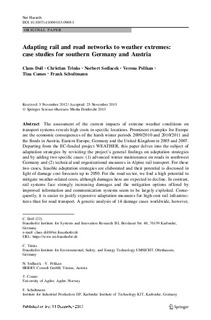| dc.contributor.author | Doll, Claus | |
| dc.contributor.author | Trinks, Christian | |
| dc.contributor.author | Sedlacek, Norbert | |
| dc.contributor.author | Pelikan, Verena | |
| dc.contributor.author | Comes, Tina | |
| dc.contributor.author | Schultmann, Frank | |
| dc.date.accessioned | 2014-01-23T13:19:24Z | |
| dc.date.available | 2014-01-23T13:19:24Z | |
| dc.date.issued | 2013 | |
| dc.identifier.citation | Doll, C., Trinks, C., Sedlacek, N., Pelikan, V., Comes, T., & Schultmann, F. (2013). Adapting rail and road networks to weather extremes: case studies for southern Germany and Austria. Natural Hazards, 1-23. doi: 10.1007/s11069-013-0969-3 | no_NO |
| dc.identifier.issn | 0921-030X | |
| dc.identifier.uri | http://hdl.handle.net/11250/138028 | |
| dc.description | Published version of an article in the journal: Natural Hazards. Also available from the publisher at: http://dx.doi.org/10.1007/s11069-013-0969-3 | no_NO |
| dc.description.abstract | The assessment of the current impacts of extreme weather conditions on transport systems reveals high costs in specific locations. Prominent examples for Europe are the economic consequences of the harsh winter periods 2009/2010 and 2010/2011 and the floods in Austria, Eastern Europe, Germany and the United Kingdom in 2005 and 2007. Departing from the EC-funded project WEATHER, this paper delves into the subject of adaptation strategies by revisiting the project’s general findings on adaptation strategies and by adding two specific cases: (1) advanced winter maintenance on roads in southwest Germany and (2) technical and organizational measures in Alpine rail transport. For these two cases, feasible adaptation strategies are elaborated and their potential is discussed in light of damage cost forecasts up to 2050. For the road sector, we find a high potential to mitigate weather-related costs, although damages here are expected to decline. In contrast, rail systems face strongly increasing damages and the mitigation options offered by improved information and communication systems seem to be largely exploited. Consequently, it is easier to justify expensive adaptation measures for high-cost rail infrastructures than for road transport. A generic analysis of 14 damage cases worldwide, however, revealed that generally awareness raising, cooperation and communication strategies are sufficient to mitigate the most severe damages by natural disasters. | no_NO |
| dc.language.iso | eng | no_NO |
| dc.publisher | Springer | no_NO |
| dc.subject | adaptation | no_NO |
| dc.subject | climate change | no_NO |
| dc.subject | extreme weather events | no_NO |
| dc.subject | forecasts | no_NO |
| dc.subject | investments | no_NO |
| dc.subject | railway operations | no_NO |
| dc.subject | road networks | no_NO |
| dc.subject | weather information systems | no_NO |
| dc.title | Adapting rail and road networks to weather extremes: case studies for southern Germany and Austria | no_NO |
| dc.type | Journal article | no_NO |
| dc.type | Peer reviewed | no_NO |
| dc.subject.nsi | VDP::Mathematics and natural science: 400::Geosciences: 450 | no_NO |
| dc.source.pagenumber | 1-23 | no_NO |
| dc.source.journal | Natural Hazards | no_NO |
| dc.identifier.doi | 10.1007/s11069-013-0969-3 | |
